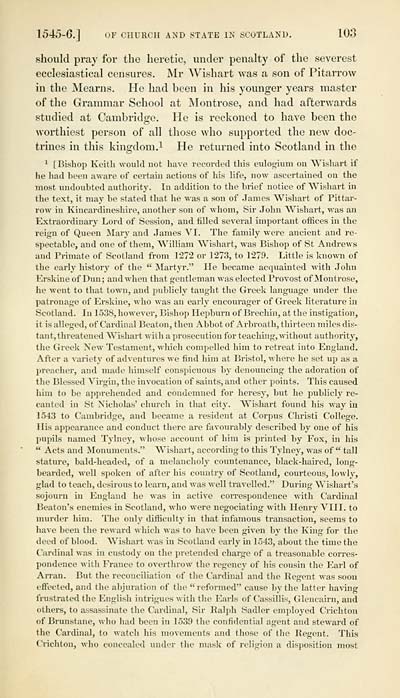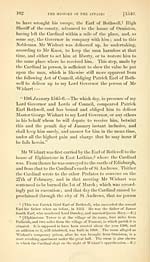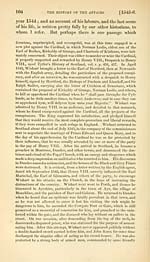Spottiswoode Society > History of the affairs of the Church and State of Scotland from the beginning of the reformation to the year 1568 > Volume 1
(239) Page 103
Download files
Complete book:
Individual page:
Thumbnail gallery: Grid view | List view

1545-6.] OF CHURCH AND STATE IN SCOTLAND. 103
should pray for the heretic, under penalty of the severest
ecclesiastical censures. Mr Wishart was a son of Pitarrow
in the Mearns. He had been in his younger years master
of the Grammar School at Montrose, and had afterwards
studied at Cambridge. He is reckoned to have been the
worthiest person of all those who supported the new doc-
trines in this kingdom. 1 He returned into Scotland in the
1 [Bishop Keith would not have recorded this eulogium on "Wishart if
he had been aware of certain actions of his life, now ascertained on the
most undoubted authority. In addition to the brief notice of Wishart in
the text, it may be stated that he was a son of James Wishart of Pittar-
row in Kincardineshire, another son of whom, Sir John Wishart, was an
Extraordinary Lord of Session, and filled several important offices in the
reign of Queen Mary and James VI. The family were ancient and re-
spectable, and one of them, William Wishart, was Bishop of St Andrews
and Primate of Scotland from 1272 or 1273, to 1279. Little is known of
the early history of the " Martyr." He became acquainted with John
Erskine of Dun; and when that gentleman was elected Provost of Montrose,
he went to that town, and publicly taught the Greek language under the
patronage of Erskine, who was an early encourager of Greek literature in
Scotland. In 1538, however, Bishop Hepburn of Brechin, at the instigation,
it is alleged, of Cardinal Beaton, then Abbot of Arbroath, thirteen miles dis-
tant, threatened Wishart with a prosecution for teaching, without authority,
the Greek New Testament, which compelled him to retreat into England.
After a variety of adventures we find him at Bristol, where he set up as a
preacher, and made himself conspicuous by denouncing the adoration of
the Blessed Virgin, the invocation of saints, and other points. This caused
him to be apprehended and condemned for heresy, but he publicly re-
canted in St Nicholas' church in that city. Wishart found his way in
1543 to Cambridge, and became a resident at Corpus Christi College.
His appearance aud conduct there are favourably described by one of his
pupils named Tylney, whose account of him is printed by Fox, in his
" Acts and Monuments." Wishart, according to this Tylney, was of" tall
stature, bald-headed, of a melancholy countenance, black-haired, long-
bearded, well spoken of after his country of Scotland, courteous, lowly,
glad to teach, desirous to learn, and was well travelled." During Wishart's
sojourn in England he was in active correspondence with Cardinal
Beaton's enemies in Scotland, who were negociating with Henry VIII. to
murder him. The only difficulty in that infamous transaction, seems to
have been the reward which Mas to have been given by the King for the
deed of blood. Wishart was in Scotland early in 1543, about the time the
Cardinal was in custody on the pretended charge of a treasonable corres-
pondence with France to overthrow the regency of his cousin the Earl of
Arran. But the reconciliation of the Cardinal and the Regent was soon
effected, and the abjuration of the "reformed" cause by the latter having
frustrated the English intrigues with the Earls of Cassillis, Glencairn, and
others, to assassinate the Cardinal, Sir Ralph Sadler employed Crichton
of Brunstane, who had been in 1539 the confidential agent and steward of
the Cardinal, to watch his movements and those of the Regent. This
Crichton, who concealed under the mask of religion a disposition most
should pray for the heretic, under penalty of the severest
ecclesiastical censures. Mr Wishart was a son of Pitarrow
in the Mearns. He had been in his younger years master
of the Grammar School at Montrose, and had afterwards
studied at Cambridge. He is reckoned to have been the
worthiest person of all those who supported the new doc-
trines in this kingdom. 1 He returned into Scotland in the
1 [Bishop Keith would not have recorded this eulogium on "Wishart if
he had been aware of certain actions of his life, now ascertained on the
most undoubted authority. In addition to the brief notice of Wishart in
the text, it may be stated that he was a son of James Wishart of Pittar-
row in Kincardineshire, another son of whom, Sir John Wishart, was an
Extraordinary Lord of Session, and filled several important offices in the
reign of Queen Mary and James VI. The family were ancient and re-
spectable, and one of them, William Wishart, was Bishop of St Andrews
and Primate of Scotland from 1272 or 1273, to 1279. Little is known of
the early history of the " Martyr." He became acquainted with John
Erskine of Dun; and when that gentleman was elected Provost of Montrose,
he went to that town, and publicly taught the Greek language under the
patronage of Erskine, who was an early encourager of Greek literature in
Scotland. In 1538, however, Bishop Hepburn of Brechin, at the instigation,
it is alleged, of Cardinal Beaton, then Abbot of Arbroath, thirteen miles dis-
tant, threatened Wishart with a prosecution for teaching, without authority,
the Greek New Testament, which compelled him to retreat into England.
After a variety of adventures we find him at Bristol, where he set up as a
preacher, and made himself conspicuous by denouncing the adoration of
the Blessed Virgin, the invocation of saints, and other points. This caused
him to be apprehended and condemned for heresy, but he publicly re-
canted in St Nicholas' church in that city. Wishart found his way in
1543 to Cambridge, and became a resident at Corpus Christi College.
His appearance aud conduct there are favourably described by one of his
pupils named Tylney, whose account of him is printed by Fox, in his
" Acts and Monuments." Wishart, according to this Tylney, was of" tall
stature, bald-headed, of a melancholy countenance, black-haired, long-
bearded, well spoken of after his country of Scotland, courteous, lowly,
glad to teach, desirous to learn, and was well travelled." During Wishart's
sojourn in England he was in active correspondence with Cardinal
Beaton's enemies in Scotland, who were negociating with Henry VIII. to
murder him. The only difficulty in that infamous transaction, seems to
have been the reward which Mas to have been given by the King for the
deed of blood. Wishart was in Scotland early in 1543, about the time the
Cardinal was in custody on the pretended charge of a treasonable corres-
pondence with France to overthrow the regency of his cousin the Earl of
Arran. But the reconciliation of the Cardinal and the Regent was soon
effected, and the abjuration of the "reformed" cause by the latter having
frustrated the English intrigues with the Earls of Cassillis, Glencairn, and
others, to assassinate the Cardinal, Sir Ralph Sadler employed Crichton
of Brunstane, who had been in 1539 the confidential agent and steward of
the Cardinal, to watch his movements and those of the Regent. This
Crichton, who concealed under the mask of religion a disposition most
Set display mode to: Large image | Transcription
Images and transcriptions on this page, including medium image downloads, may be used under the Creative Commons Attribution 4.0 International Licence unless otherwise stated. ![]()
| Permanent URL | https://digital.nls.uk/79599656 |
|---|
| Description | Volume I. |
|---|---|
| Attribution and copyright: |
|

